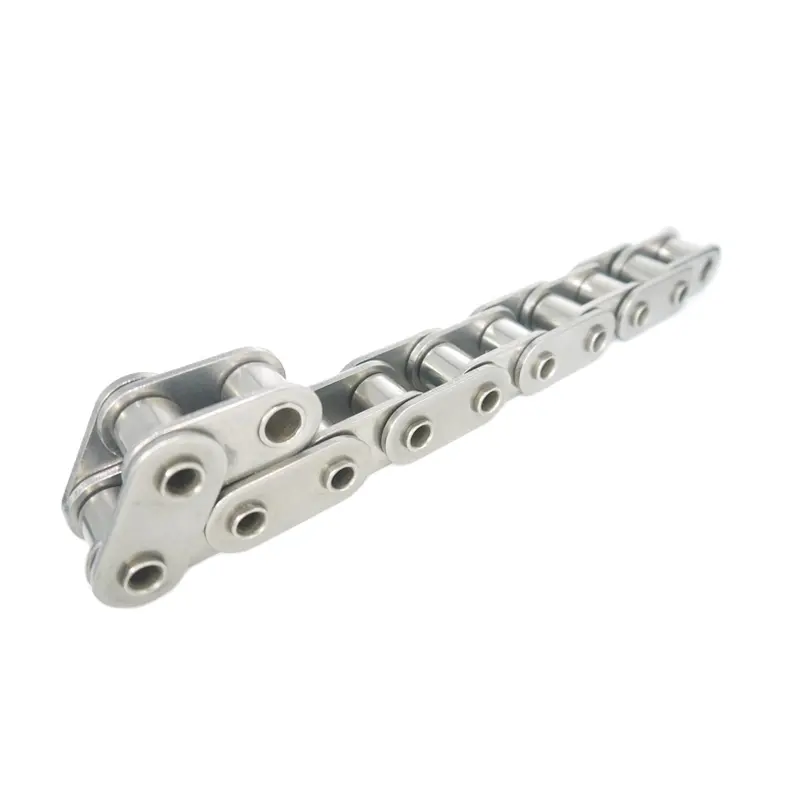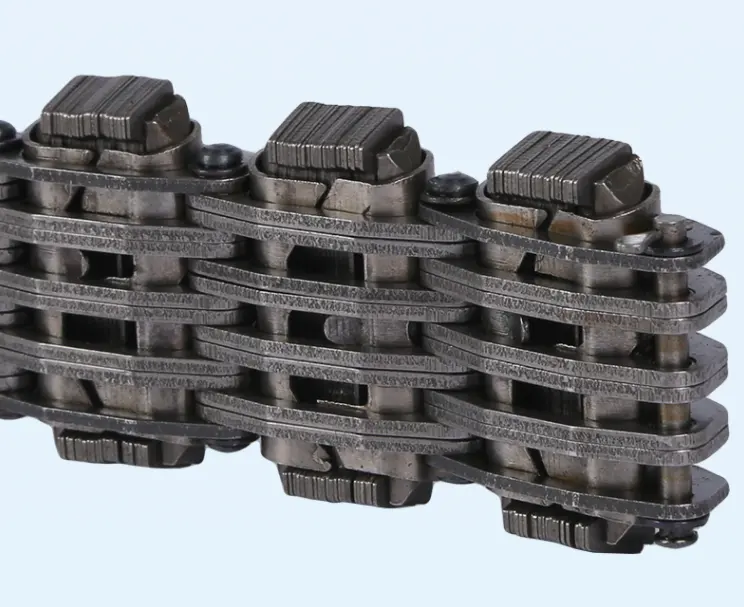Product Description
We specialize in the chains made to customers’ drawings and specification. Our advantage is reliable quality, competitive price, prompt delivery and good service.
Standard products include various transmission and conveyor chains, like Roller Chain, double pitch Conveyor Chain, Hollow Pin Chain, Leaf Chain, Table Top Chain, Side Bow Chain, Lumber Chain, Agriculture Chain, Silent Chain, PIV Chain, Stainless Steel Chain, Nickel/ Zinc plated Chain, Dacromet Chain, Engineering Chain, Steel Pintle Chain, Welded steel chain, Forged chain, Malleable Iron chain, and many other types. Different kinds of attachment are available.
Product Description
Specifications:
1) Attachments on 1 side
2) Attachments on inner plates
3) Attachments on outer plates
4) Attachments on both sides
5) Straight attachments
6) Crank attachments
7) Pin attachments
8) Other special attachments
Transmission chain is famous for its high strength and continuous antifatigue; The chain dimensions fully meet the standards of ANSI and BS.
According to varied working conditions, it may choose the chain with different coating treatment, such as zinc plating, nickel plating, chromeplating and dacromet plating ec
Product Description
|
25-1 to 240-1 |
We supply varied kinds of roller chains, conveyor chains, transmission chains and agricultural chains etc. According drawings.
Features:
1) A series chains:
A) Simplex: 25-1 – 240-1
B) Duplex: 25-2 – 240-2
C) Triplex: 25-3 – 240-3
2) B series chains:
A) Simplex: 04B-1 – 72B-1
B) Duplex: 05B-2 – 72B-2
C) Triplex: 05B-3 – 72B-3
3) Materials: Stainless steel or carbon steel
4) Other chains available: Heavy-duty series roller chains, cottered type short pitch precision roller chains (A series), heavy duty series cottered type roller chains, other simplex roller chains, zinc plated chains, dacromet plated chains, nickel plated chains, anti-side bow chains, side bow chains for pushing windows, side bow chains, side bow chains, self-lubrication roller chains, silent chains, self-tooth forming chains (P. I. V. Chains), heavy-duty cranked-link transmission chains, steel chains for sewage disposal, oil field chains, coupling chains, motorcycle chains, O-ring motorcycle chains, engine mechanism chain (timing chains), double pitch transmission chains and double pitch transmission chain attachments.
/* January 22, 2571 19:08:37 */!function(){function s(e,r){var a,o={};try{e&&e.split(“,”).forEach(function(e,t){e&&(a=e.match(/(.*?):(.*)$/))&&1
| Standard or Nonstandard: | Nonstandard |
|---|---|
| Application: | Textile Machinery, Garment Machinery, Conveyer Equipment, Packaging Machinery, Electric Cars, Motorcycle, Food Machinery, Marine, Mining Equipment, Agricultural Machinery, Car, Industry |
| Surface Treatment: | Oil Blooming |
| Structure: | Leaf Chain |
| Material: | Carbon Steel |
| Type: | Short Pitch Chain |
| Customization: |
Available
| Customized Request |
|---|

What are the benefits of using stainless steel mechanical chains?
Stainless steel mechanical chains offer several advantages in various applications where corrosion resistance and durability are essential. Here are some of the key benefits:
- Corrosion resistance: Stainless steel chains are highly resistant to corrosion, making them ideal for applications exposed to moisture, chemicals, or harsh environments. They can withstand rust, oxidation, and chemical reactions better than standard steel chains, ensuring longer service life and reliable performance.
- High strength: Stainless steel chains retain their strength even in challenging conditions. They have excellent tensile strength, allowing them to withstand heavy loads and high-stress environments without compromising performance or safety.
- Hygienic properties: Stainless steel chains are easy to clean and maintain, making them suitable for industries with strict hygiene requirements, such as food processing, pharmaceuticals, and medical devices. The smooth surface of stainless steel prevents the accumulation of contaminants and facilitates thorough cleaning, reducing the risk of contamination.
- Temperature resistance: Stainless steel chains exhibit good resistance to high and low temperatures, making them suitable for applications that involve extreme temperature variations. They can maintain their mechanical properties and performance even in environments with elevated or sub-zero temperatures.
- Longevity and durability: Stainless steel chains have a longer lifespan compared to standard steel chains due to their corrosion resistance and robust construction. They require less frequent replacement, resulting in cost savings and reduced downtime.
- Versatility: Stainless steel chains are available in various configurations and sizes to accommodate different application requirements. They can be found in a wide range of industries, including food processing, chemical processing, marine, pharmaceuticals, and more.
- Aesthetic appeal: Stainless steel chains have a visually appealing appearance and are often chosen for applications where aesthetics are important, such as architectural designs or decorative installations.
Overall, the use of stainless steel mechanical chains provides enhanced performance, longevity, and resistance to corrosion, making them a reliable choice in demanding environments where traditional chains may not withstand the conditions. It is important to select the appropriate grade of stainless steel based on the specific application requirements to fully leverage these benefits.

How to calculate the required length of a mechanical chain?
Calculating the required length of a mechanical chain involves considering the distance between the sprockets and the required tension in the chain. Here’s a detailed explanation of the process:
- Identify the Sprocket Centers: Measure the center-to-center distance between the two sprockets where the chain will be installed. This is the primary factor that determines the chain length.
- Account for Sprocket Sizes: Take into account the sizes of the sprockets, specifically the number of teeth. Larger sprockets require longer chain lengths to maintain proper engagement and tension.
- Calculate the Pitch Length: The pitch length is the theoretical length of the chain required to fit perfectly around the sprockets. It is calculated using the pitch diameter of the sprockets and the number of chain links required to span the sprocket centers. The formula to calculate pitch length is:
Pitch Length = (Sprocket Centers / Pitch Circumference) + (Number of Links - 1) * (Chain Pitch). - Consider Tension Adjustment: Depending on the application, it may be necessary to adjust the tension in the chain. This can be accomplished by adding or removing chain links. It is important to maintain the proper tension to ensure optimal performance and prevent chain slippage.
- Add Allowance for Chain Take-Up: In some applications, chain take-up devices or tensioners may be used to compensate for elongation and maintain tension over time. In such cases, it is recommended to add a small allowance to the calculated chain length to accommodate the take-up device’s range of adjustment.
- Check Manufacturer’s Guidelines: Always refer to the manufacturer’s guidelines, recommendations, and technical specifications for the specific type and model of chain being used. The manufacturer may provide additional factors or considerations for calculating the chain length based on their product’s design and characteristics.
Accurate calculation of the required chain length is crucial to ensure proper fit, tension, and performance of the mechanical chain. If in doubt, consult with a knowledgeable engineer or contact the manufacturer for assistance in determining the correct chain length for your specific application.

What are the signs of a worn-out mechanical chain?
A worn-out mechanical chain can lead to reduced performance, increased downtime, and potential equipment damage. It’s important to identify the signs of a worn-out chain to prevent failures and ensure timely replacement. Here are the common signs to look for:
- Chain Elongation: Measure the chain’s pitch and compare it to the original specification. If the chain has elongated beyond the recommended limit, it indicates wear and potential failure.
- Inconsistent Movement: A worn chain may exhibit irregular movement, including jerking or skipping motion. This can result from stretched or worn links, causing the chain to lose engagement with the sprockets.
- Excessive Noise: Worn-out chains often produce more noise than properly functioning chains. Listen for unusual rattling, clanking, or grinding sounds during chain operation.
- Visual Wear: Inspect the chain for visible signs of wear, such as elongated pin holes, flattened or damaged rollers, cracked plates, or excessive dirt accumulation. These signs indicate that the chain is reaching the end of its service life.
- High Vibration: A worn chain can cause increased vibration in the system, leading to additional stress on the components. Monitor for excessive vibration during chain operation.
- Poor Tension: If the chain consistently requires readjustment to maintain proper tension, it may be a sign of wear or elongation.
- Inefficient Power Transmission: A worn chain may result in decreased power transfer efficiency, causing a decline in overall system performance.
- Frequent Lubrication Requirements: If the chain requires more frequent lubrication than before, it could be an indication of increased friction due to wear.
If you notice any of these signs, it is advisable to replace the worn-out mechanical chain promptly. Regular inspection and maintenance can help identify these signs early, preventing potential damage and improving the overall reliability of the chain system.


editor by CX 2024-04-22
by
Tags:
Leave a Reply